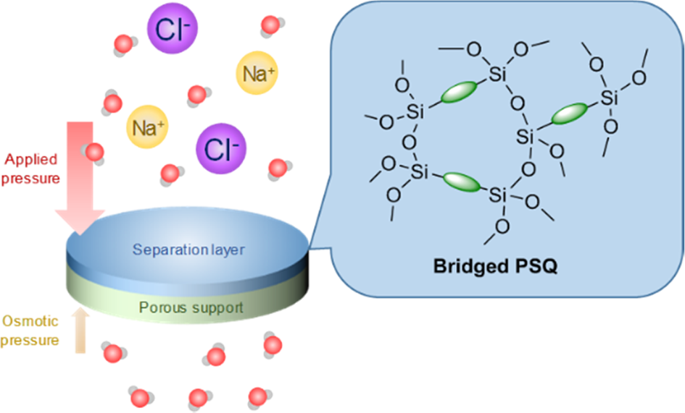Our official English website, www.x-mol.net, welcomes your
feedback! (Note: you will need to create a separate account there.)
Bridged polysilsesquioxane membranes for water desalination
Polymer Journal ( IF 2.3 ) Pub Date : 2019-07-19 , DOI: 10.1038/s41428-019-0237-9 Kazuki Yamamoto , Joji Ohshita
Polymer Journal ( IF 2.3 ) Pub Date : 2019-07-19 , DOI: 10.1038/s41428-019-0237-9 Kazuki Yamamoto , Joji Ohshita

|
Water desalination through a reverse osmosis (RO) membrane is an important technology for producing pure water from seawater. High-performance membrane materials have been extensively developed because these materials are useful as core elements in practical water separation processes. Bridged polysilsesquioxane (PSQ)-derived membranes are promising candidates for robust RO membranes because they exhibit high thermal stability and chlorine resistance compared to conventional aromatic polyamide membranes. This review reports on our recent studies involving the development of RO membranes based on bridged PSQs. Our goal is to attain high water permeance with high salt rejection by optimizing the bridged PSQ structure. We have found that the introduction of hydrophilic and/or rigid bridging units tends to enhance water permeability. The preparation and evaluation of bridged PSQ RO membranes for water desalination based on the effects of the bridge structures are described. The bridged PSQ membranes are typically prepared by using a sol–gel process that involves hydrolysis/condensation of bridged alkoxysilane precursors to form sols followed by coating of the resulting sols and calcination of the coated sols to afford the gel membranes. Because the sol–gel process is a complicated multistep process, the development of a new and simpler process has been pursued. Herein, we summarize the recently introduced interfacial polymerization approach as a new method to readily prepare bridged PSQ RO membranes. Water desalination through a reverse osmosis (RO) membrane is an important technology for producing pure water from seawater. High-performance membrane materials have been extensively developed because these materials are useful as core elements in practical water separation processes. Bridged polysilsesquioxane (PSQ)-derived membranes are promising candidates for robust RO membranes because they exhibit high thermal stability and chlorine resistance compared to conventional aromatic polyamide membranes. This review reports on our recent studies involving the development of RO membranes based on bridged PSQs.
中文翻译:

用于海水淡化的桥联聚倍半硅氧烷膜
通过反渗透 (RO) 膜进行海水淡化是从海水中生产纯水的一项重要技术。高性能膜材料已被广泛开发,因为这些材料可用作实际水分离过程中的核心元件。桥接聚倍半硅氧烷 (PSQ) 衍生的膜是坚固的 RO 膜的有希望的候选者,因为与传统的芳族聚酰胺膜相比,它们具有较高的热稳定性和耐氯性。本综述报告了我们最近的研究,涉及基于桥接 PSQ 的 RO 膜的开发。我们的目标是通过优化桥接 PSQ 结构来实现高透水率和高脱盐率。我们已经发现亲水和/或刚性桥接单元的引入倾向于增强水渗透性。描述了基于桥结构效应的用于海水淡化的桥接 PSQ RO 膜的制备和评估。桥接 PSQ 膜通常通过使用溶胶-凝胶工艺制备,该工艺涉及桥接烷氧基硅烷前体的水解/缩合以形成溶胶,然后涂覆所得溶胶并煅烧涂覆的溶胶以提供凝胶膜。由于溶胶-凝胶过程是一个复杂的多步骤过程,因此一直在寻求开发一种新的更简单的过程。在此,我们总结了最近引入的界面聚合方法,作为一种易于制备桥接 PSQ RO 膜的新方法。通过反渗透 (RO) 膜进行海水淡化是从海水中生产纯水的一项重要技术。高性能膜材料已被广泛开发,因为这些材料可用作实际水分离过程中的核心元件。桥接聚倍半硅氧烷 (PSQ) 衍生的膜是坚固的 RO 膜的有希望的候选者,因为与传统的芳族聚酰胺膜相比,它们具有较高的热稳定性和耐氯性。本综述报告了我们最近的研究,涉及基于桥接 PSQ 的 RO 膜的开发。
更新日期:2019-07-19
中文翻译:

用于海水淡化的桥联聚倍半硅氧烷膜
通过反渗透 (RO) 膜进行海水淡化是从海水中生产纯水的一项重要技术。高性能膜材料已被广泛开发,因为这些材料可用作实际水分离过程中的核心元件。桥接聚倍半硅氧烷 (PSQ) 衍生的膜是坚固的 RO 膜的有希望的候选者,因为与传统的芳族聚酰胺膜相比,它们具有较高的热稳定性和耐氯性。本综述报告了我们最近的研究,涉及基于桥接 PSQ 的 RO 膜的开发。我们的目标是通过优化桥接 PSQ 结构来实现高透水率和高脱盐率。我们已经发现亲水和/或刚性桥接单元的引入倾向于增强水渗透性。描述了基于桥结构效应的用于海水淡化的桥接 PSQ RO 膜的制备和评估。桥接 PSQ 膜通常通过使用溶胶-凝胶工艺制备,该工艺涉及桥接烷氧基硅烷前体的水解/缩合以形成溶胶,然后涂覆所得溶胶并煅烧涂覆的溶胶以提供凝胶膜。由于溶胶-凝胶过程是一个复杂的多步骤过程,因此一直在寻求开发一种新的更简单的过程。在此,我们总结了最近引入的界面聚合方法,作为一种易于制备桥接 PSQ RO 膜的新方法。通过反渗透 (RO) 膜进行海水淡化是从海水中生产纯水的一项重要技术。高性能膜材料已被广泛开发,因为这些材料可用作实际水分离过程中的核心元件。桥接聚倍半硅氧烷 (PSQ) 衍生的膜是坚固的 RO 膜的有希望的候选者,因为与传统的芳族聚酰胺膜相比,它们具有较高的热稳定性和耐氯性。本综述报告了我们最近的研究,涉及基于桥接 PSQ 的 RO 膜的开发。











































 京公网安备 11010802027423号
京公网安备 11010802027423号